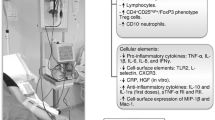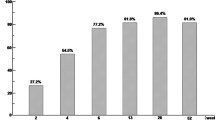Abstract
Adacolumn selective granulocyte and monocyte apheresis (GMA) depletes activated leukocytes in patients with ulcerative colitis (UC). However, this per se cannot fully explain the efficacy of GMA. We have investigated the effects of GMA on the expression of toll-like receptors (TLRs) and plasma interleukin-8 (IL-8). Twenty-two patients with clinical activity index (CAI) of 5–17, 15 with total colitis and 7 with left-sided colitis, were included. Each patient could receive up to 10 GMA sessions, at 1 or 2 sessions per week. GMA was added to the patients’ ongoing medication following a relapse or worsening UC, but no additional medication was given. Further, at entry and pre-GMA, blood samples were taken for full blood cell count, expression of TLRs on leukocytes, and plasma IL-8. Seventy-five percent of patients achieved remission after the 10th session (CAI, ≤4; P < 0.005) and there was a marked fall in C-reactive protein (P < 0.01), plasma IL-8 (P < 0.001), and granulocytes (P < 0.05) but an increase in lymphocytes (P < 0.05). The expression of TLR2 on granulocytes was down-modulated (P < 0.05) together with suppression of inflammatory cytokines produced by peripheral blood leukocytes. In conclusion, GMA appears to be an effective adjunct therapy to induce remission in the majority of patients, who are then spared from excess drug therapy. The procedure is associated with sustained immunomodulation. Control studies should strengthen these findings.




Similar content being viewed by others
References
Shimoyama T, Sawada K, Hiwatashi N (2001) Safety and efficacy of granulocytes and monocyte adsorption apheresis in patients with active ulcerative colitis: a multicenter study. J Clin Apher 16:1–9
Saniabadi AR, Hanai H, Lofberg R (2003) Adacolumn, an adsorptive carrier based granulocyte and monocyte apheresis device for the treatment of inflammatory and refractory diseases associated with leukocytes. Ther Apher Dial 7:48–59
Hanai H, Watanabe F, Takeuchi K, et al. (2003) Leukcocyte adsorptive apheresis for the treatment of active ulcerative colitis:a prospective uncontrolled pilot study. Clin Gastroenterol Hepatol 1:28–35
Kashiwagi N, Sugimura K, Koiwai H, Saniabadi A (2002) Immunomodulatory effects of granulocyte and monocyte adsorption apheresis as a treatment for patients with ulcerative colitis. Dig. Dis Sci 6:1334–1341
Suzuki Y, Yoshimura N, Saniabadi AR, Saito Y (2004) Selective granulocytes and monocyte adsorptive apheresis as a first-line treatment for steroid naïve patients with active ulcerative colitis:a prospective uncontrolled study. Dig Dis Sci 49:565–571
Saniabadi AR, Hanai H, Suzuki Y, Bjarnason I, Lofberg R (2005) Adacolumn for selective leukocytapheresis as a non-pharmacological treatment for patients with disorders of the immune system:an adjunct or an alternative to drug therapy? J Clin Apher 20:171–184
Kanke K, Nakano M, Hiraishi H (2004) Evaluation of granulocyte/monocyte apheresis therapy for active ulcerative colitis. Dig Liv Dis 36:512–518
Naganuma M, Funakoshi S, Sakuraba A, Hibi T (2004) Granulocytapheresis is useful as an alternative therapy in patients with steroid-refractory or -dependent ulcerative colitis. Inflamm Bowel Dis 10:251–257
Yamamoto T, Umegae S, Kitagawa T (2004) Granulocyte and monocyte adsorptive apheresis in the treatment of active distal ulcerative colitis: a prospective, pilot study. Aliment Pharmacol Ther 20:783–792
Domenech E, Hinojosa J, Esteve-Comas M, Gassull A, Spanish Group for the Study of Crohn's Disease and Ulcerative Colitis (GETECCU) (2004) Granulocyteaphaeresis in steroid-dependent inflammatory bowel disease: a prospective, open, pilot study. Aliment Pharmacol Ther 20:1347–1352
Suzuki Y, Yoshimora N, Saito Y, Saniabadi A (2006) A retrospective search for predictors of clinical response to selective granulocyte and monocyte apheresis in patients with ulcerative colitis. Dig Dis Sci (in press)
McCarthy DA, Rampton DS, Liu Y-C (1991) Peripheral blood neutrophils in inflammatory bowel disease:morphological evidence of in vivo activation in active disease. Clin Exp Immunol 86:489–493
Rugtveit J, Brandtzaeg P, Halstensen TS, Fausa O, Scott H (1994) Increased macrophage subsets in inflammatory bowel disease:apparent recruitment from peripheral blood monocytes. Gut 35:669–674
Meuret G, Bitzi A, Hammer B (1978) Macrophage turnover in Crohn's disease and ulcerative colitis. Gastroenterology 74:501–503
Brannigan AE, O’Connell PR, Hurley H (2000) Neutrophil apoptosis is delayed in patients with inflammatory bowel disease. Shock 13:361–366
Cassatella MA (1995) The production of cytokines by polymorphonuclear neutrophils. Immunol Today 16:21–26
Nikolaus S, Bauditz J, Gionchetti P (1998) Increased secretion of pro-inflammatory cytokines by circulating polymorphonuclear neutrophils and regulation by interleukin-10 during intestinal inflammation. Gut 42:470–476
Mahida YR (2000) The key role of macrophages in the immunopathogenesis of inflammatory bowel disease. Inflamm Bowel Dis 6:21–33
Hanauer SB (2006) Inflammatory bowel disease: epidemiology, pathogenesis, and therapeutic opportunities. Inflamm Bowel Dis 12:S3–S9
Allison MC, Dhillon AP, Lewis WG, Pounder RE, eds (1998) Inflammatory bowel disease. Mosby, London, pp 15–95
Tibble JA, Sigthorsson G, Bridger D, Fagerhol MK, Bjarnason I (2000) Surrogate markers of intestinal inflammation are predictive of relapse in patients with inflammatory bowel disease. Gastroenterology 119:15–22
Limburg P, David M, Ahlquist A, Sandborn WJ (2000) Faecal calprotectin levels predict colorectal inflammation among patients with chronic diarrhoea referred for colonoscopy. Am J Gastroenterol 95:2831–2837
Hiraishi K, Takeda Y, Shiobara N, Saniabadi A (2003) Studies on the mechanisms of leukocyte adhesion to cellulose acetate beads:an in vitro model to assess the efficacy of cellulose acetate carrier-based granulocyte and monocyte adsorptive apheresis. Ther Apher Dial 7:334–340
D’Arrigo C, Candal-Couto JJ, Greer M (1993) Human neutrophil Fc receptor-mediated adhesion under flow: a hallow fiber model of intravascular arrest. Clin Exp Immunol 100:173–179
Pierik M, Joossens S, Van Steen K (2006) Toll-like receptor-1, -2, and -6 polymorphisms influence disease extension in inflammatory bowel diseases. Inflamm Bowel Dis 12:1–8
Rachmilewitz D (on behalf of an international study group) (1989) Coated mesalazine (5-aminosalicylic acid) versus sulphasalazine in the treatment of active ulcerative colitis: a randomized trial. Br Med J 298:82–86
Kurt-Jones EA, Whitney MC, Padgett A, Gosselin K, Newburger PE, Finberg RW (2002) Role of toll-like receptor 2 (TLR2) in neutrophil activation: GM-CSF enhances TLR2 expression and TLR2-mediated interleukin 8 responses in neutrophils. Blood 100:1860–1868
Swaak AJ, van den Brink HG, Aarden LA (1997) Cytokine production in whole blood cell cultures of patients with rheumatoid arthritis. Ann Rheum Dis 56:693–695
Lerebours E, Bussel A, Modigliani R, Bastit D, Florent C, Rabian C (1994) Treatment of Crohn's disease by lymphocyte apheresis:a randomized controlled trial. Gastroenterology 107:357–361
Isaacs KL, Lewis JD, Sandborn WJ, Sands BE, Targan SR (2005) State of the art:IBD therapy and clinical trials in IBD. Inflamm Bowel Dis 11:S3–S12
Barrat FJ, Meeker T, Gregorio J, Chan JH, Uematsu S, Akira S, Chang B, Duramad O, Coffman RL (2005) Nucleic acids of mammalian origin can act as endogenous ligands for Toll-like receptors and may promote systemic lupus erythematosus. J Exp Med 202:1131–1139
Kanai K, Watanabe M (2005) Clinical application of human CD4+CD25+ regulatory T cells for the treatment of inflammatory bowel diseases. Expert Opin Biol Ther 5:451–462
King C, Ilic A, Koelsch K, Sarvetnick N (2004) Homeostatic expansion of T cells during immune insufficiency generates autoimmunity. Cell 117:265–277
Sleasman JW (1996) The association between immunodeficiency and the development of autoimmune disease. Adv Dent Res 10:57–61
Banerjee D, Liou HC, Sen R (2005) c-Rel-dependent priming of naive T Cells by inflammatory cytokines. Immunity 23:445–458
Hanai H, Watanabe F, Saniabadi A, Matsushita I, Takeuchi K, Iida T (2002) Therapeutic efficacy of granulocyte and monocyte adsorption apheresis in severe active ulcerative colitis. Dig Dis Sci 47:2349–2353
Dionne S, D’Agata ID, Hiscott J, Vanounou T, Seidman EG (1998) Colonic explant production of IL-1 and its receptor antagonist is imbalanced in inflammatory bowel disease (IBD). Clin Exp Immunol 112:435–442
Author information
Authors and Affiliations
Corresponding author
Rights and permissions
About this article
Cite this article
Aoki, H., Nakamura, K., Yoshimatsu, Y. et al. Adacolumn Selective Leukocyte Adsorption Apheresis in Patients with Active Ulcerative Colitis: Clinical Efficacy, Effects on Plasma IL-8, and Expression of Toll-like Receptor 2 on Granulocytes. Dig Dis Sci 52, 1427–1433 (2007). https://doi.org/10.1007/s10620-006-9406-8
Received:
Accepted:
Published:
Issue Date:
DOI: https://doi.org/10.1007/s10620-006-9406-8




